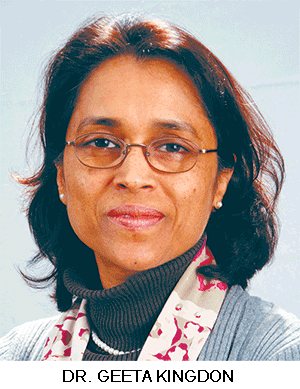 The Annual Status of Education Report (ASER) 2016 released in Delhi on January 18, indicates that learning outcomes in rural primaries countrywide continue to be pitiable, with only 19-20 percent of government school students and 38-44 percent of class III private primary students being able to read class II texts correctly and complete two-digit subtraction sums. Attendance is also poor, with only 71 percent of enrolled children and 85 percent of teachers being present in school on the day of the survey.
The Annual Status of Education Report (ASER) 2016 released in Delhi on January 18, indicates that learning outcomes in rural primaries countrywide continue to be pitiable, with only 19-20 percent of government school students and 38-44 percent of class III private primary students being able to read class II texts correctly and complete two-digit subtraction sums. Attendance is also poor, with only 71 percent of enrolled children and 85 percent of teachers being present in school on the day of the survey.
How have parents responded to this reality of poor learning outcomes? The ASER survey shows significant ‘privatisation’ of education, with the percentage of rural children attending private schools doubling from 16 percent in 2005 to 31 percent in 2016. Evidently parents hold them in high esteem, despite most of them being officially ‘unrecognised’. Yet in the public discourse, they are routinely demonised as fake teaching shops playing with the lives of children.
They are demonised because of the perceived high price of private school education. But National Sample Survey data 2014-15 indicates that the median tuition fee of private unaided schools countrywide is Rs.417 per month (Rs.292 in villages and Rs.542 in cities). On the other hand, per pupil expenditure in the government school system is estimated at Rs.960 per month, taking the weighted mean of per-pupil expenditure for 18 states presented by Ambrish Dongre and Avani Kapur of the Delhi-based Centre for Policy Research, and published in the Economic and Political Weekly (September 2016).
Against this backdrop, the official attitude towards private unrecognised schools (whose number is estimated at almost half of all private unaided schools in the country) is intriguing. In the states, education officials routinely penalise and shut down private schools non-compliant with the infrastructure norms of the Right of Children to Free & Compulsory Education (RTE) Act, 2009. The National Independent Schools Alliance (NISA) estimates that in 2014-16, 6,500 unrecognised private schools were forcibly shut down, with another 8,000 issued closure notices and an additional 15,000 having received closure threats. The closure of budget private schools, which charge low tuition fees and therefore can’t afford to fulfil the specified infrastructure norms of the RTE Act, is a tragedy since most children from such schools generally cannot afford to migrate to recognised private schools which demand higher tuition fees.
Therefore, education policy needs to become sympathetic rather than punitive towards budget private schools, and acknowledge their contribution in brightening an otherwise bleak education landscape. One option is to subsidise their compliance with the expensive infrastructure norms prescribed by the RTE Act. Another is to relax the most difficult recognition norms — that all school buildings should comply with the National Building Code, for example. This would be elementary justice since less than 7 percent of the country’s 1.2 million government schools are compliant with the infrastructure and other norms prescribed by the RTE Act.
Moreover liberalisation of education is likely to evoke a positive supply-side response from edupreneurs ready to provide quality education, as happened after liberalisation of the Indian economy and industry which, when freed from the shackles of overbearing regulations, immediately doubled the annual rate of GDP growth to 7 percent per year. Nothing will be gained by vilifying private schools, to which millions of poor parents have turned in desperation.
Sensible education policies based on the realities of K-12 education need to be formulated, rather than policies based on rosy idealism or wishful thinking. Several models of public-private partnerships (PPP) in education have been successful around the world. If, for instance, education vouchers are given to below-poverty-line households, their children could study in private schools of their choice rather than in non-performing government schools. The basic idea behind encashable education vouchers is that the government should fund students instead of schools, i.e, money should follow students and schools of their choice.
Advocacy of PPPs and school vouchers is not based on the premise that private schools are necessarily superior to government schools, or free markets ideology, but on sound principles of equity and efficiency. School vouchers enable governments to provide socially disadvantaged and voiceless children with the same set of choices available to middle-class children, and a policy of affirmative action could be followed to ensure that poorest households receive highest-value vouchers. The cause of efficiency is served by encouraging competition — which will improve both public and private schools — as indeed competition has improved the services of airlines and telephone companies.
Education policy choices shape the lives and future prospects of millions of children. Therefore, the nation needs evidence-informed education policies, based on ground realities of private and public schooling in India. The children of India deserve a New Education Policy that addresses these live issues.
(Dr. Geeta Gandhi Kingdon is Chair of Economics of Education and International Development, University College London)